Quality Characteristics, Sensory Profiles and Ethylene Production of Stored ‘Abate Fetel’ Pears Sorted at Harvest by Time-Resolved Reflectance Spectroscopy
Abstract
:1. Introduction
2. Results
2.1. At Harvest
2.2. After Storage
2.2.1. μa670
2.2.2. Quality Characteristics
2.2.3. Ethylene Production
2.2.4. Sensory Profiles
2.2.5. PCA Analysis
3. Discussion
4. Materials and Methods
4.1. Fruit and Experimental Plan
4.2. TRS Measurements
4.2.1. TRS Set-Up
4.2.2. TRS Data Analysis
4.3. Quality Parameters
4.3.1. Skin Color
4.3.2. Texture Properties
4.3.3. Starch Hydrolysis, Soluble Solids Content and Titratable Acidity
4.4. Ethylene Production
4.5. Sensory Analysis
4.6. Statistical Analysis
5. Conclusions
Author Contributions
Funding
Data Availability Statement
Conflicts of Interest
References
- Predieri, S.; Gatti, E. Effects of cold storage and shelf-life on sensory quality and consumer acceptance of ‘Abate Fetel’ pears. Postharvest Biol. Technol. 2009, 51, 342–348. [Google Scholar] [CrossRef]
- Rizzolo, A.; Grassi, M.; Vanoli, M. Storage protocol modulates ripening behavior and physiological disorders of 1-MCP treated ‘Abate Fetel’ pears. Acta Hortic. 2018, 1194, 701–708. [Google Scholar] [CrossRef]
- Rizzolo, A.; Grassi, M.; Vanoli, M. 1-methylcyclopropene application: Storage temperature and atmosphere modulate sensory quality changes in shelf life of ‘Abbé Fétel’ pears. Postharvest Biol. Technol. 2014, 92, 87–97. [Google Scholar] [CrossRef]
- Vanoli, M.; Grassi, M.; Rizzolo, A. Ripening behavior and physiological disorders of ‘Abate Fetel’ pears treated at harvest with 1-MCP and stored at different temperatures and atmospheres. Postharvest Biol. Technol. 2016, 111, 274–285. [Google Scholar] [CrossRef]
- Bertolini, P.; Guizzardi, M.; Casadei, C. Influence of calcium and of oxygen levels on soft scald of stored ‘Abbè Fètel’ pears. Acta Hortic. 2002, 596, 851–856. [Google Scholar] [CrossRef]
- Rizzolo, A.; Grassi, M.; Vanoli, M. La conservazione delle pere in AC dinamica: Scambi gassosi e incidenza delle fisiopatie. Frutticoltura 2010, 72, 38–44. [Google Scholar]
- Folchi, A.; Bertolini, P.; Mazzoni, D. Influence of controlled atmosphere and dynamic controlled atmosphere on physiology, scald prevention and CA related disorders of ‘Abbé Fétel’ pears during long-term storage. Acta Hortic. 2015, 1071, 195–202. [Google Scholar] [CrossRef]
- Predieri, S.; Gatti, E.; Medoro, C.; Cianciabella, M.; Infante, R.; Mari, L. Consumer tests for monitoring optimal ‘Abate Fetel’ pear eating quality. Eur. J. Hort. Sci. 2014, 79, 36–42. [Google Scholar]
- Escribano, S.; Lopez, A.; Sivertsen, H.; Biasi, W.V.; Macnish, A.J.; Mitcham, E.J. Impact of 1-methylcyclopropene treatment on the sensory quality of ‘Bartlett’ pear fruit. Postharvest Biol. Technol. 2016, 111, 305–313. [Google Scholar] [CrossRef]
- Torregrosa, L.; Echeverria, G.; Illa, J.; Giné-Bordonaba, J. Ripening behaviour and consumer acceptance of ‘Conference’ pears during shelf life after long term DCA-storage. Postharvest Biol. Technol. 2019, 155, 94–101. [Google Scholar] [CrossRef]
- Brouwer, B.; Mensink, M.; Hogeveen-van Echtelt, E.; Woltering, E.J. Pre-storage application of 1-methylcyclopropene does not affect the flavour of ‘Conference’ pears ripened after 8 months of commercial-standard controlled atmosphere storage. Postharvest Biol. Technol. 2021, 174, 111448. [Google Scholar] [CrossRef]
- Lunati, F. Ripartenza in salita per aumento dei costi e consumi stagnanti. Frutticoltura 2022, 9, 6–8. [Google Scholar]
- Wang, M.; Xu, Y.; Yang, Y.; Mu, B.; Nikitina, M.A.; Xiao, X. Vis/NIR optical biosensors applications for fruit monitoring. Biosens. Bioelectron. 2022, 11, 100197. [Google Scholar] [CrossRef]
- Wu, X.; Li, G.; He, F. Nondestructive analysis of internal quality in pears with a self-made near-infrared spectrum detector combined with multivariate data processing. Foods 2021, 10, 1315. [Google Scholar] [CrossRef]
- Han, D.; Tu, R.; Lu, C.; Liu, X.; Wen, Z. Nondestructive detection of brown core in the Chinese pear ‘Yali’ by transmission visible–NIR spectroscopy. Food Control 2006, 17, 604–608. [Google Scholar] [CrossRef]
- Eccher Zerbini, P.; Grassi, M.; Cubeddu, R.; Pifferi, A.; Torricelli, A. Non-destructive detection of brown heart in pears by time-resolved reflectance spectroscopy. Postharvest Biol. Technol. 2002, 25, 87–97. [Google Scholar] [CrossRef]
- Cruz, S.; Guerra, R.; Brazio, A.; Cavaco, A.M.; Antunes, D.; Passos, D. Nondestructive simultaneous prediction of internal browning disorder and quality attributes in ‘Rocha’ pear (Pyrus communis L.) using VIS-NIR spectroscopy. Postharvest Biol. Technol. 2021, 179, 111562. [Google Scholar] [CrossRef]
- Khodabakhshian, R.; Emadi, B. Application of Vis/ SNIR hyperspectral imaging in ripeness classification of pear. Int. J. Food Prop. 2017, 20, S3149–S3163. [Google Scholar] [CrossRef]
- Paz, P.; Sánchez, M.T.; Pérez-Marín, D.; Guerrero, J.E.; Garrido-Varo, A. Instantaneous quantitative and qualitative assessment of pear quality using near infrared spectroscopy. Comput. Electron. Agric. 2009, 69, 24–32. [Google Scholar] [CrossRef]
- Mishra, P.; Woltering, E.; Brouwer, B.; Hogeveen-van Echtelt, E. Improving moisture and soluble solids content prediction in pear fruit using ear-infrared spectroscopy with variable selection and model updating approach. Postharvest Biol. Technol. 2021, 171, 111348. [Google Scholar] [CrossRef]
- Lu, R.; Van Beers, R.; Saeys, W.; Li, C.; Cen, H. Measurement of optical properties of fruits and vegetables: A review. Postharvest Biol. Technol. 2020, 159, 111003. [Google Scholar] [CrossRef]
- Lammertyn, J.; Peirs, A.; De Baedemaeker, J.; Nicolaï, B.M. Light penetration properties of NIR radiation in fruit with respect to non-destructive quality assessment. Postharvest Biol. Technol. 2000, 18, 121–132. [Google Scholar] [CrossRef]
- Cubeddu, R.; D’Andrea, C.; Pifferi, A.; Taroni, P.; Torricelli, A.; Valentini, G.; Dover, C.; Johnson, D.; Ruiz-Altisent, M.; Valero, C. Nondestructive quantification of chemical and physical properties of fruits by time-resolved reflectance spectroscopy in the wavelength range 650–1000 nm. Appl. Opt. 2001, 40, 538–543. [Google Scholar] [CrossRef] [PubMed]
- Saeys, W.; Velazco-Roa, M.A.; Thennadil, S.N.; Ramon, H.; Nicolai, B.M. Optical properties of apple skin and flesh in the wavelength range from 350 to 2200 nm. Appl. Opt. 2008, 47, 908–919. [Google Scholar] [CrossRef] [PubMed]
- Torricelli, A.; Spinelli, L.; Contini, D.; Vanoli, M.; Rizzolo, A.; Eccher Zerbini, P. Time-resolved reflectance spectroscopy for non-destructive assessment of food quality. Sens. Instrum. Food Qual. Saf. 2008, 2, 82–89. [Google Scholar] [CrossRef]
- Rizzolo, A.; Vanoli, M. Time-resolved technique for measuring optical properties and quality of food. In Light Scattering Technology for Food Property, Quality and Safety Assessment; Lu, R., Ed.; CRC Press, Taylor & Francis Group: Boca Raton, FL, USA, 2016; pp. 187–224. ISBN 978-1-4822-6334-3. [Google Scholar]
- Vanoli, M.; Buccheri, M. Overview of the methods for assessing harvest maturity. Stewart Postharvest Rev. 2012, 1, 4. [Google Scholar]
- Vanoli, M.; Van Beers, R.; Sadar, N.; Rizzolo, A.; Buccheri, M.; Grassi, M.; Lovati, F.; Nicolaï, B.; Aernouts, B.; Watté, R.; et al. Time- and spatially-resolved spectroscopy to determine the bulk optical properties of ‘Braeburn’ apples after ripening in shelf life. Postharvest Biol. Technol. 2020, 168, 111233. [Google Scholar] [CrossRef]
- Rizzolo, A.; Vanoli, M.; Torricelli, A.; Spinelli, L.; Sadar, N.; Zanella, A. Modeling optical properties of Braeburn apples during fruit maturation on the tree. Acta Hortic. 2021, 1311, 113–121. [Google Scholar] [CrossRef]
- Rizzolo, A.; Bianchi, G.; Vanoli, M.; Lurie, S.; Spinelli, L.; Torricelli, A. Electronic nose to detect volatile compound profile and quality changes in ‘Spring Belle’ peach (Prunus persica L.) during cold storage in relation to fruit optical properties measured by time-resolved reflectance spectroscopy. J. Agric. Food Chem. 2013, 61, 1671–1685. [Google Scholar] [CrossRef]
- Rizzolo, A.; Vanoli, M.; Spinelli, L.; Torricelli, A. Sensory profiles of various stored fruit species are affected by maturity class assessed by time-resolved reflectance spectroscopy at harvest. Acta Hortic. 2015, 1099, 249–256. [Google Scholar] [CrossRef]
- Costa, G.; Rocchi, L.; Farneti, B.; Busatto, N.; Spinelli, F.; Vidoni, S. Use of nondestructive devices to support pre- and postharvest fruit management. Horticulturae 2017, 3, 12. [Google Scholar] [CrossRef]
- Vanoli, M.; Rizzolo, A.; Grassi, M.; Farina, A.; Pifferi, A.; Spinelli, L.; Torricelli, A. Time-resolved reflectance spectroscopy nondestructively reveals structural changes in ‘Pink Lady®’ apples during storage. Procedia Food Sci. 2011, 1, 81–89. [Google Scholar] [CrossRef]
- Vanoli, M.; Rizzolo, A.; Grassi, M.; Torricelli, A.; Zanella, A.; Spinelli, L. Characterizing apple texture during storage through mechanical, sensory and optical properties. Acta Hortic. 2015, 1079, 383–390. [Google Scholar] [CrossRef]
- Eccher Zerbini, P.; Cambiaghi, P.; Grassi, M.; Rizzolo, A.; Cubeddu, R.; Pifferi, A.; Torricelli, A.; Biscotti, G. Effect of 1-MCP on ‘Abbé Fétel’ pears sorted at harvest by time-resolved reflectance spectroscopy. Acta Hortic. 2005, 682, 965–972. [Google Scholar] [CrossRef]
- Calvo, G.; Candan, A.P.; Gomila, T. Post-harvest performance of ‘Abate Fetel’ pears grown in Argentina in relation to harvest time. Acta Hortic. 2011, 909, 725–730. [Google Scholar] [CrossRef]
- Folchi, A.; Bertolini, P.; Mazzoni, D. Preventing ripening blockage in 1-MCP treated ‘Abate Fetel’ pears by storage temperature management. Acta Hortic. 2015, 1079, 215–221. [Google Scholar] [CrossRef]
- Chiriboga, M.A.; Schotsmans, W.C.; Larrigaudiere, C.; Dupille, E.; Recasens, I. Responsiveness of ‘Conference’ pears to 1-methylcyclopropene: The role of harvest date, orchard location and year. J. Sci. Food Agric. 2013, 93, 619–625. [Google Scholar] [CrossRef] [PubMed]
- Vanoli, M.; Grassi, M.; Bianchi, G.; Buccheri, M.; Rizzolo, A. ‘Conference’ and ‘Abbé Fétel’ pears treated with 1-methylcyclopropene: Physiological and quality implications of initial low oxygen stress and controlled atmosphere storage. Adv. Hort. Sci. 2015, 29, 84–96. [Google Scholar]
- Hendges, M.V.; Neuwald, D.A.; Steffens, C.A.; Vidrih, R.; Zlati´c, E.; do Amarante, C.V.T. 1-MCP and storage conditions on the ripening and production of aromatic compounds in Conference and Alexander Lucas pears harvested at different maturity stages. Postharvest Biol. Technol. 2018, 146, 18–25. [Google Scholar] [CrossRef]
- Vanoli, M.; Eccher Zerbini, P.; Spinello, L.; Torricelli, A.; Rizzolo, A. Polyuronide content and correlation to optical properties measured by time-resolved reflectance spectroscopy in ‘Jonagored’ apples stored in normal and controlled atmosphere. Food Chem. 2009, 115, 1450–1457. [Google Scholar] [CrossRef]
- Calvo, G.; Candan, A.P.; Civello, M.; Giné-Bordonaba, J.; Larrigaudière, C. An insight into the role of fruit maturity at harvest on superficial scald development in ‘Beurré D’Anjou’ pear. Sci. Hortic. 2015, 192, 173–179. [Google Scholar] [CrossRef]
- Lindo-García, V.; Giné-Bordonaba, J.; Leclerc, C.; Ubach, D.; Larrigaudière, C. The relationship between ethylene- and oxidative-related markers at harvest with the susceptibility of pears to develop superficial scald. Postharvest Biol. Technol. 2020, 163, 111135. [Google Scholar] [CrossRef]
- Cortellino, G.; Piazza, L.; Spinelli, L.; Torricelli, A.; Rizzolo, A. Influence of maturity degree, modified atmosphere and anti-browning dipping on texture changes kinetics of fresh-cut apples. Postharvest Biol. Technol. 2017, 124, 137–146. [Google Scholar] [CrossRef]
- Saquet, A.A. Storage of pears. Sci. Hortic. 2019, 246, 1009–1016. [Google Scholar] [CrossRef]
- Zucoloto, M.; Antoniolli, L.R.; Siqueira, D.L.; Czermainski, A.B.C.; Salomão, L.C.C. Conditioning temperature for inducing uniform ripening of ‘Abate Fetel’ pears. Rev. Ciência Agronômica 2016, 47, 344–350. [Google Scholar] [CrossRef]
- Martinenghi, E.; Di Sieno, L.; Contini, D.; Sanzaro, M.; Pifferi, A.; Dalla Mora, A. Time-resolved single-photon detection module based on silicon photomultiplier: A novel building block for time-correlated measurement systems. Rev. Sci. Instrum. 2016, 87, 073101. [Google Scholar] [CrossRef]
- Martelli, F.; Delbianco, S.; Ismaelli, A.; Zaccanti, G. Light Propagation through Biological Tissue and Other Diffusive Media: Theory, Solutions, and Software; SPIE Press: Washington, DC, USA, 2009; p. 57. [Google Scholar]
- Rizzolo, A.; Cambiaghi, P.; Grassi, M.; Eccher Zerbini, P. Influence of 1-methylcyclopropene and storage atmosphere on changes in volatile compounds and fruit quality in Conference pears. J. Agric. Food Chem. 2005, 53, 9781–9789. [Google Scholar] [CrossRef]
- Bianchi, G.; Eccher Zerbini, P.; Rizzolo, A. Short-term training and assessment for performance of a sensory descriptive panel for the olfactometric analysis of aroma extracts. J. Sens. Stud. 2009, 24, 149–165. [Google Scholar] [CrossRef]

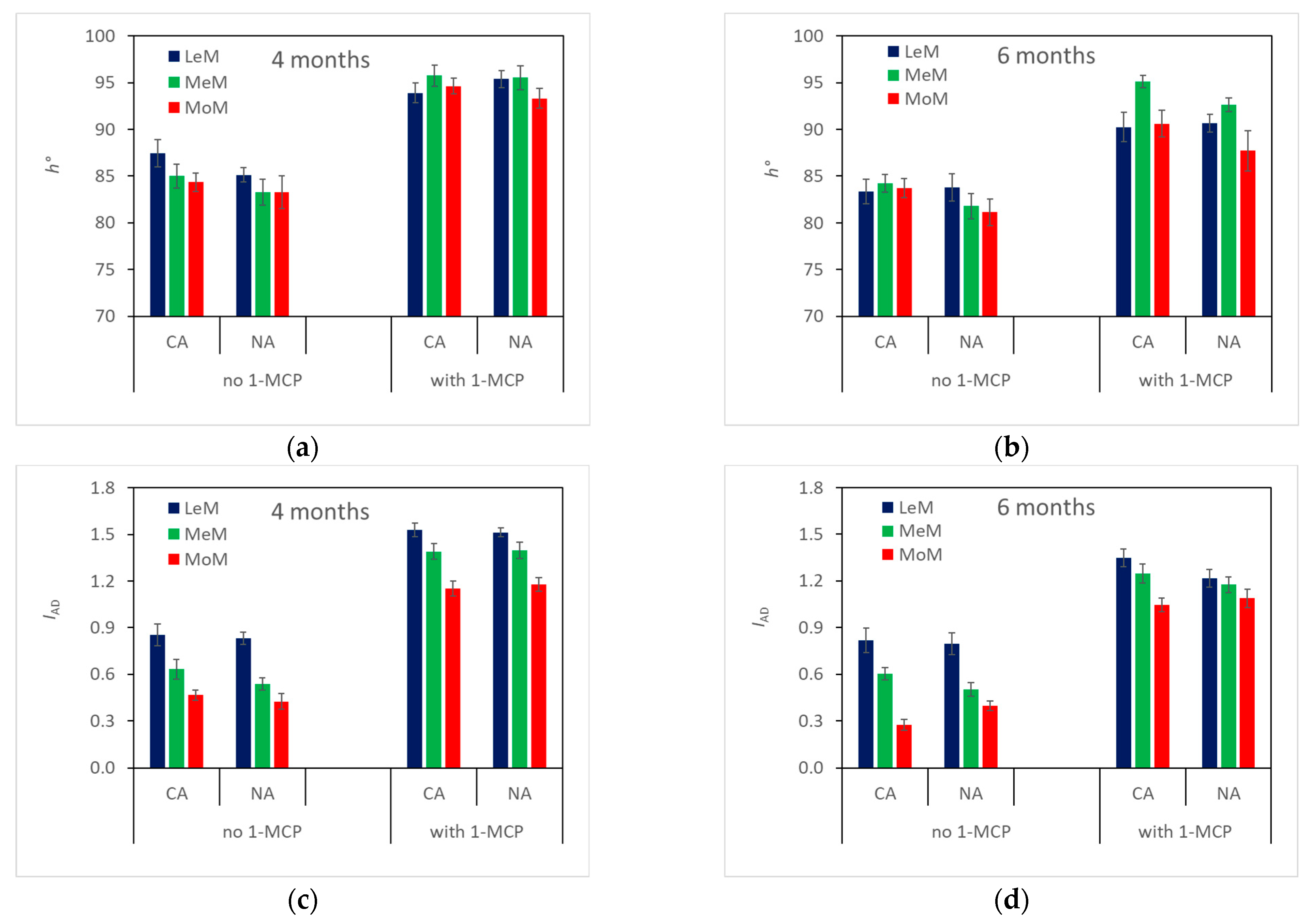
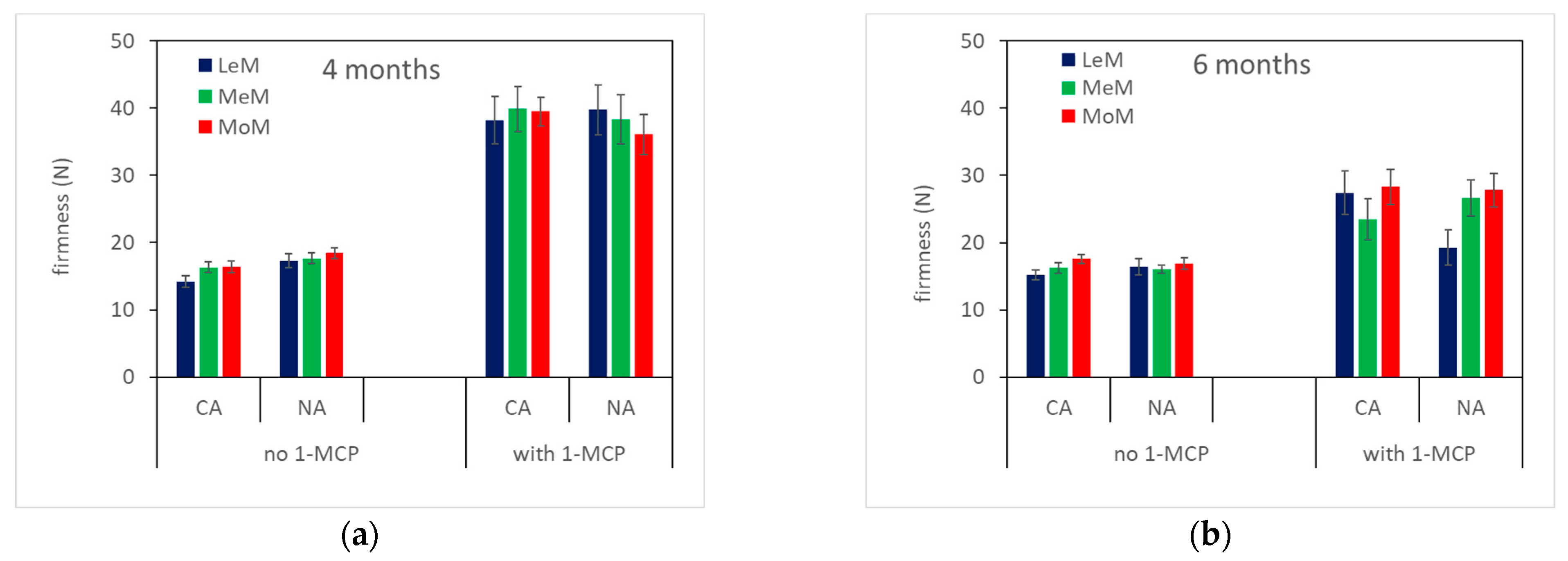
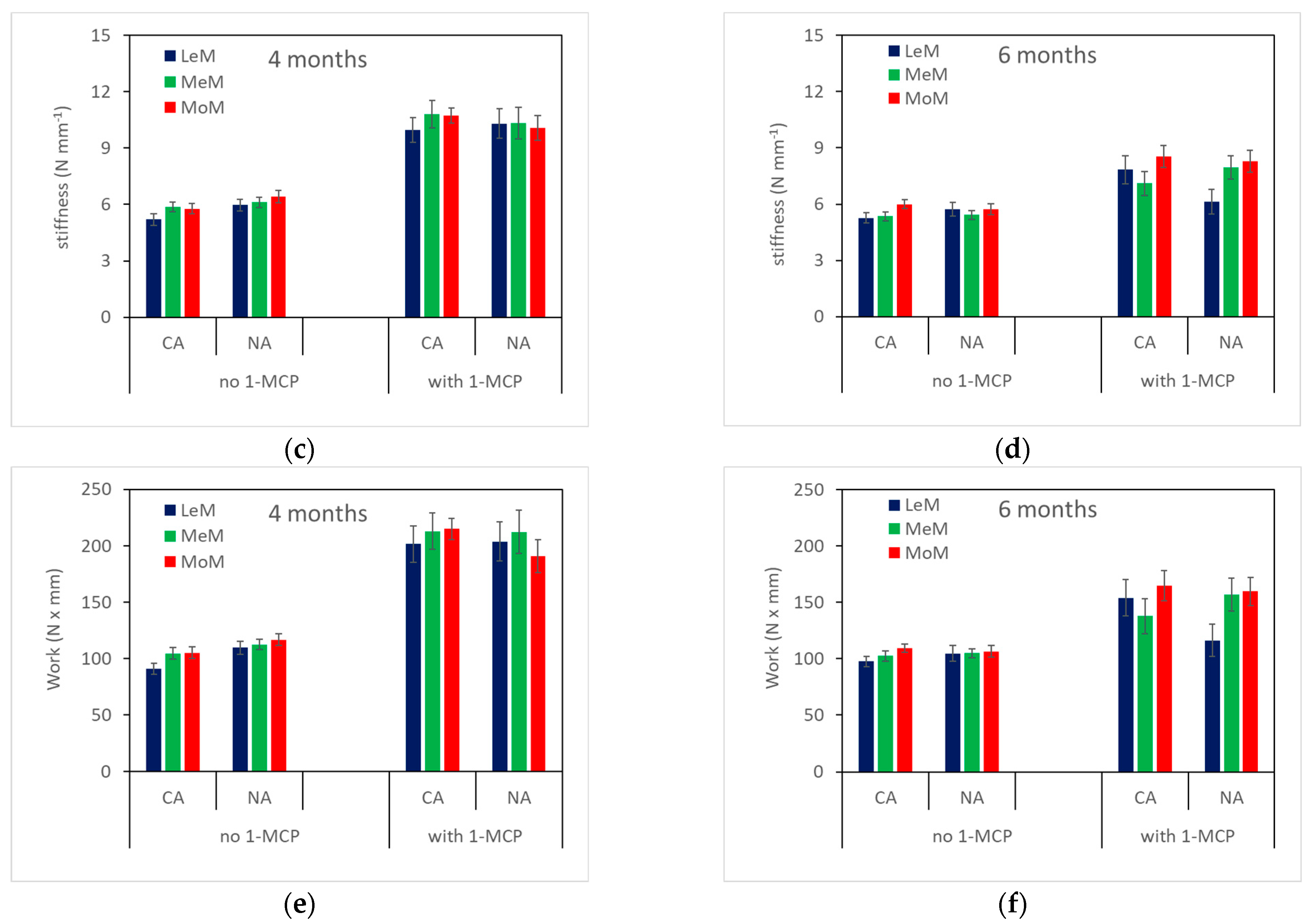
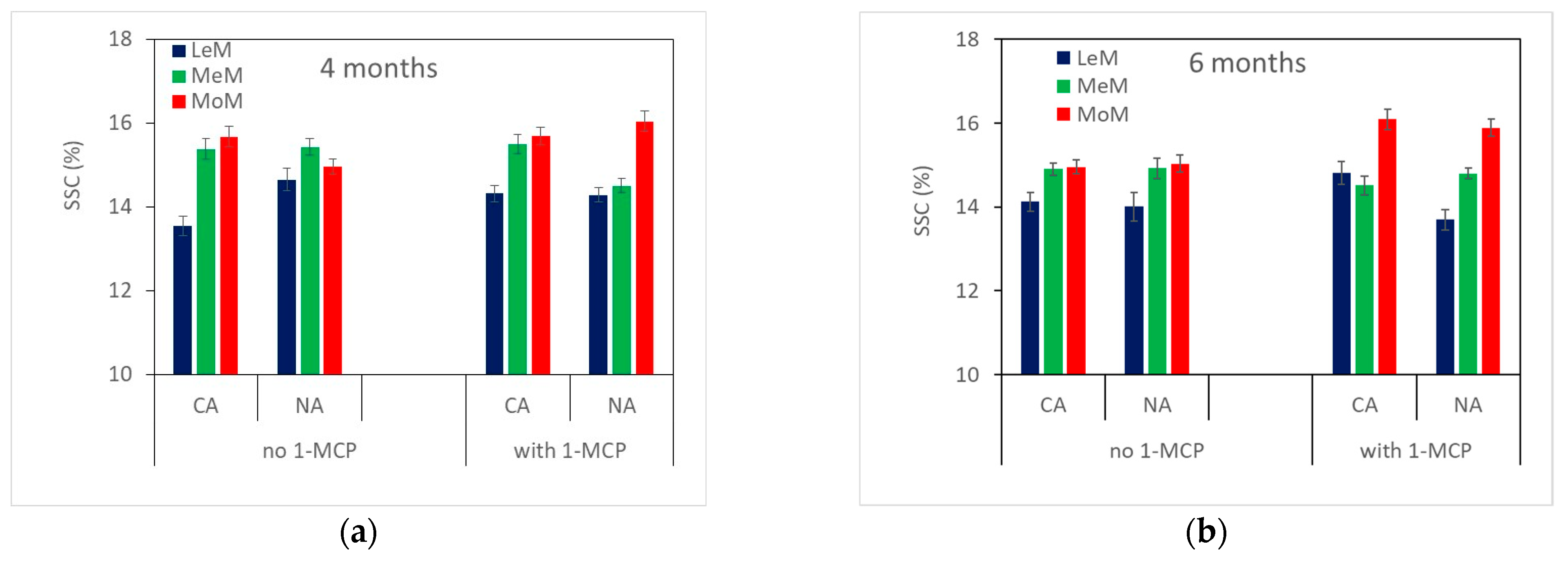
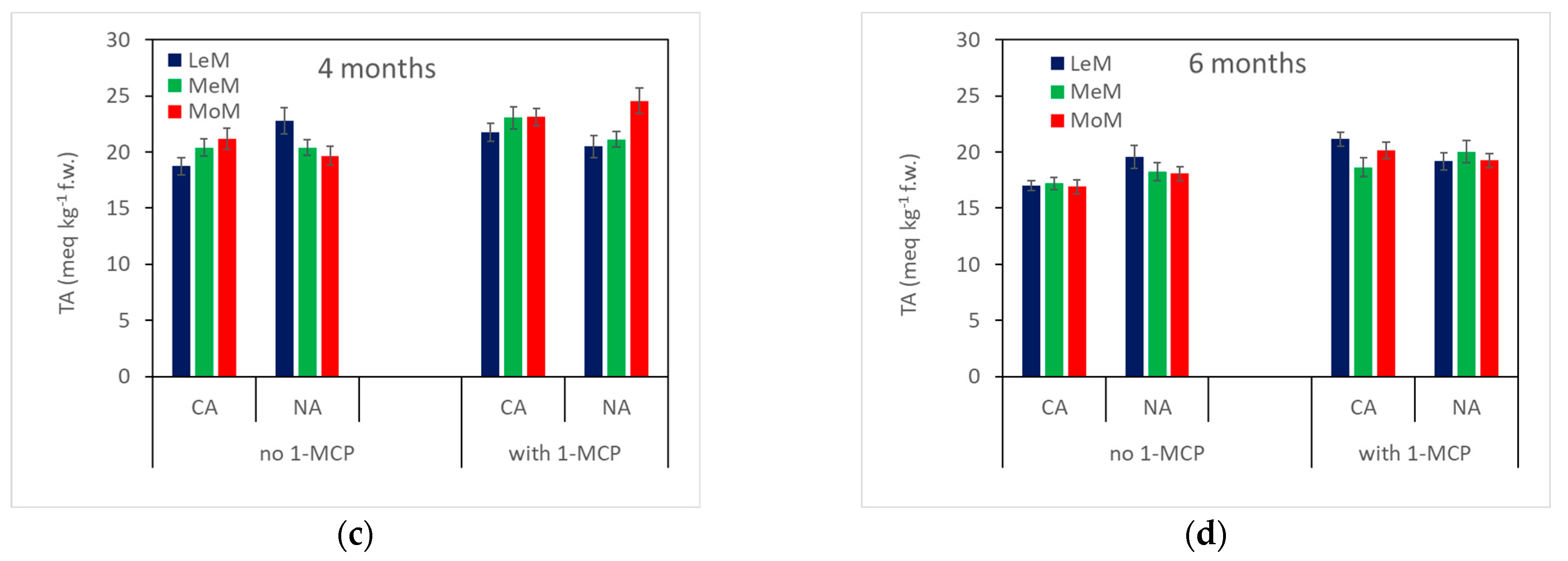


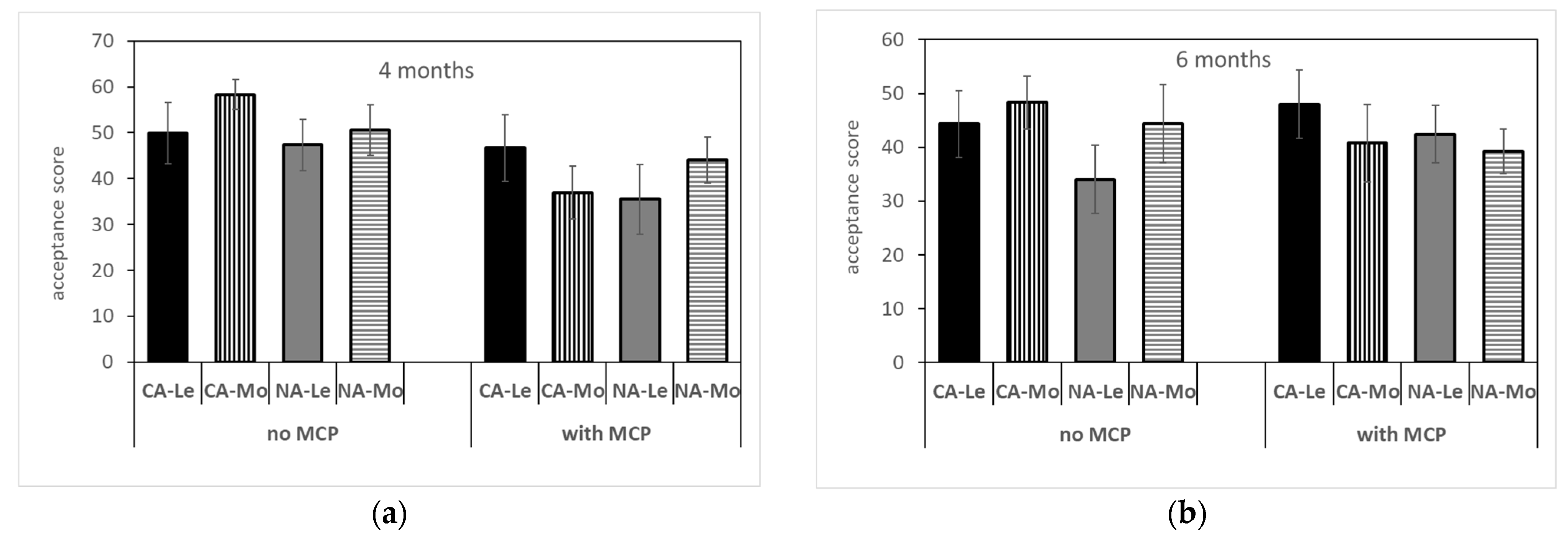
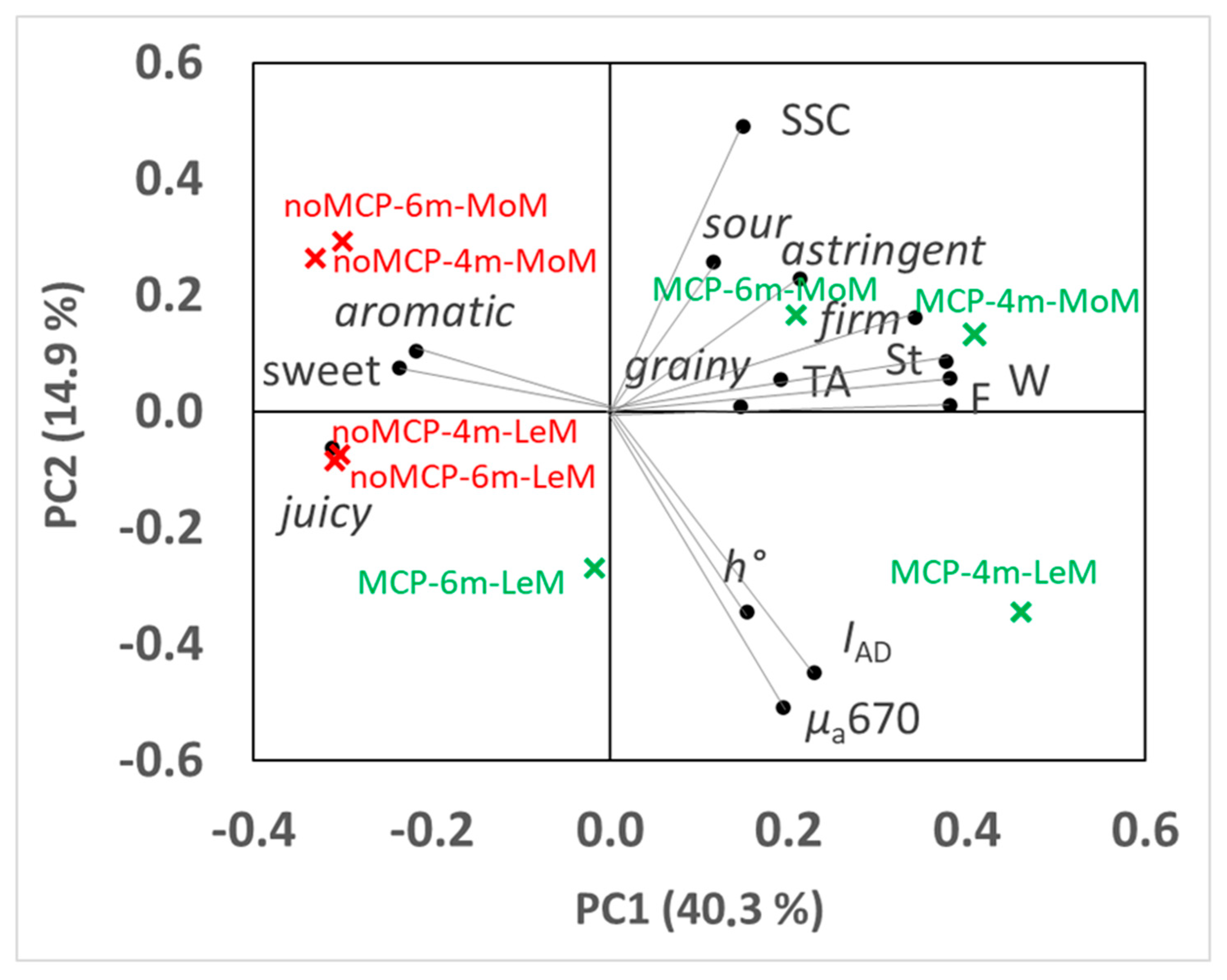
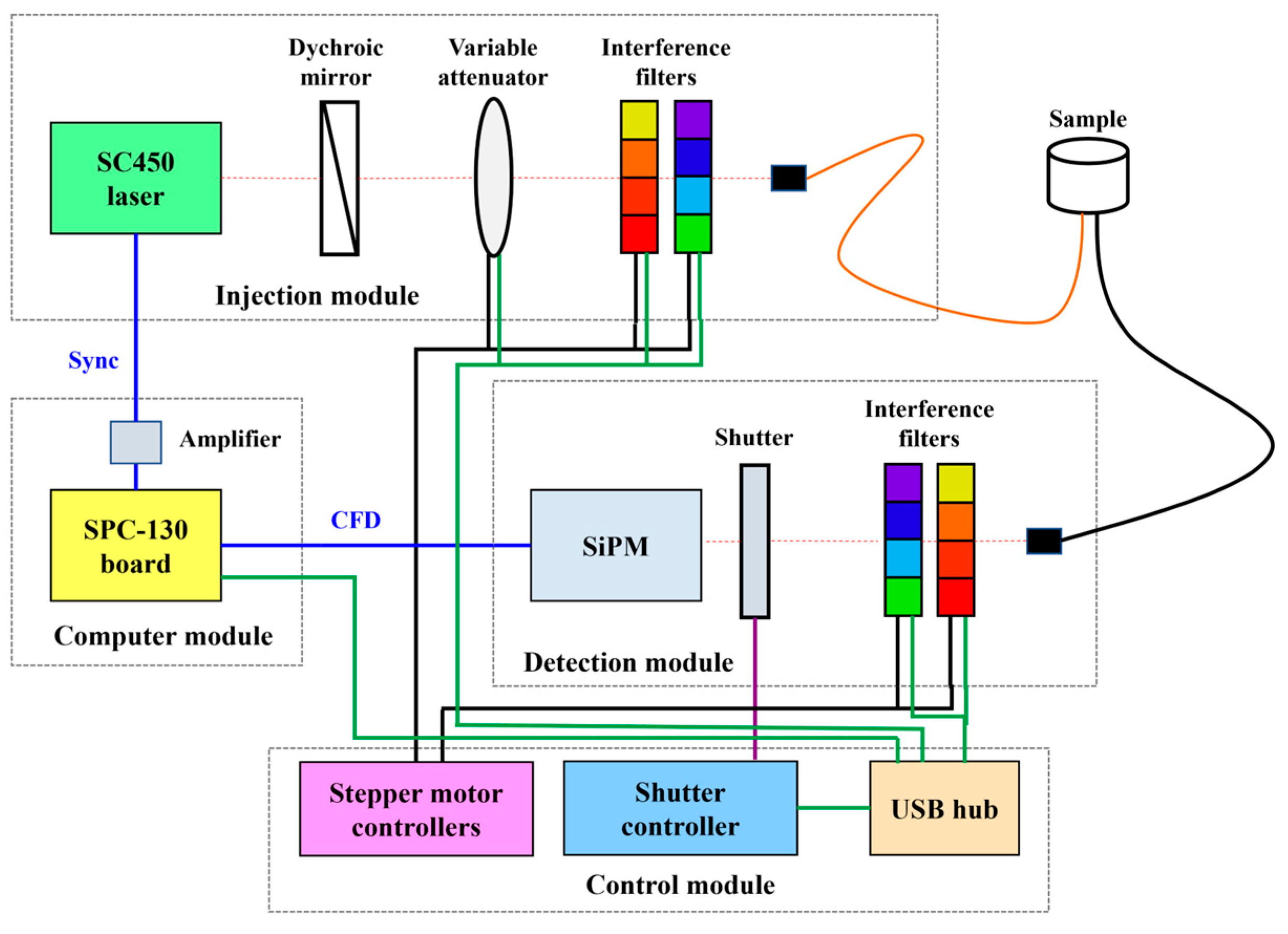
| LeM | MeM | MoM | Mean | p-Value | |
|---|---|---|---|---|---|
| μa670 (cm−1) | 0.290 ± 0.049 | 0.137 ± 0.003 | 0.098 ± 0.003 | 0.176 ± 0.019 | *** |
| Skin color h° | 103.7 ± 1.5 | 102.3 ± 1.4 | 98.7 ± 2.1 | 101.5 ± 1.0 | ns |
| Skin color IAD | 1.87 ± 0.02 | 1.81 ± 0.03 | 1.65 ± 0.05 | 1.78 ± 0.02 | *** |
| Starch hydrolysis | 6.6 ± 0.5 | 4.4 ± 0.4 | 2.9 ± 0.2 | 4.6 ± 0.3 | *** |
| Firmness (N) | 53.2 ± 1.5 | 49.1 ± 1.4 | 46.9 ± 1.3 | 49.7 ± 0.9 | ** |
| Stiffness (N mm−1) | 14.8 ± 0.6 | 14.5 ± 0.3 | 14.0 ± 0.2 | 14.4 ± 0.2 | ns |
| Work (N × mm) | 303.0 ± 8.8 | 286.1 ± 7.4 | 273.8 ± 6.0 | 287.7 ± 4.6 | * |
| SSC (%) | 13.6 ± 0.2 | 14.2 ± 0.2 | 15.0 ± 0.2 | 14.3 ± 0.1 | *** |
| TA (meq kg−1) | 30.0 ± 1.4 | 26.1 ± 0.9 | 28.3 ± 1.4 | 28.2 ± 0.8 | ns |
| h° | IAD | F | St | W | SSC | TA | |
|---|---|---|---|---|---|---|---|
| Main effects | |||||||
| Storage time (A) | ns | ns | ns | ns | ns | ns | ns |
| 1-MCP treatment (B) | *** | *** | ns | ** | ns | ns | ** |
| Storage atmosphere (C) | ns | ns | ns | ns | * | ns | ns |
| TRS maturity class (D) | ** | * | ns | ns | ns | * | ns |
| Interactions | |||||||
| A × B | ns | * | ** | * | ns | ns | ns |
| A × C | ns | ns | ns | ns | ns | ns | ns |
| A × D | ns | ns | ns | ns | ns | * | ns |
| B × C | ns | ns | ns | ns | ns | ns | ns |
| B × D | ns | ns | * | ns | ns | ns | ns |
| C × D | ns | ns | ns | ns | ns | ns | ns |
| A × B × C | ns | ns | ns | ns | ns | ns | ns |
| A × b × D | ns | ns | ns | ns | ns | ns | ns |
| A × C × D | ns | ns | ns | ns | ns | ns | ns |
| B × C × D | ns | ns | ns | ns | * | ns | ns |
| A × B × C × D | ns | ns | ns | ns | ns | ns | ns |
| µa670 | h° | IAD | F | St | W | SSC | TA | FF | J | Gr | Sw | So | As | Ar | Acp | |
|---|---|---|---|---|---|---|---|---|---|---|---|---|---|---|---|---|
| µa670 | 1 | |||||||||||||||
| h° | 0.42 | 1 | ||||||||||||||
| IAD | 0.83 | 0.58 | 1 | |||||||||||||
| F | 0.44 | 0.36 | 0.48 | 1 | ||||||||||||
| St | 0.34 | 0.30 | 0.41 | 0.96 | 1 | |||||||||||
| W | 0.38 | 0.32 | 0.43 | 0.99 | 0.98 | 1 | ||||||||||
| SSC | −0.37 | −0.08 | −0.17 | 0.36 | 0.45 | 0.40 | 1 | |||||||||
| TA | 0.12 | 0.30 | 0.30 | 0.39 | 0.39 | 0.38 | 0.30 | 1 | ||||||||
| FF | 0.22 | 0.18 | 0.33 | 0.75 | 0.80 | 0.79 | 0.45 | 0.39 | 1 | |||||||
| J | −0.23 | −0.18 | −0.25 | −0.64 | −0.65 | −0.66 | −0.28 | −0.24 | −0.65 | 1 | ||||||
| Gr | 0.23 | 0.18 | 0.17 | 0.33 | 0.30 | 0.31 | 0.17 | 0.05 | 0.26 | −0.21 | 1 | |||||
| Sw | −0.26 | −0.08 | −0.26 | −0.41 | −0.40 | −0.42 | −0.00 | −0.19 | −0.43 | 0.61 | −0.12 | 1 | ||||
| So | −0.05 | 0.01 | 0.10 | 0.19 | 0.24 | 0.22 | 0.32 | 0.25 | 0.33 | −0.13 | −0.05 | −0.02 | 1 | |||
| As | 0.07 | −0.04 | 0.10 | 0.43 | 0.43 | 0.44 | 0.27 | 0.17 | 0.46 | −0.38 | 0.24 | −0.30 | 0.35 | 1 | ||
| Ar | −0.28 | −0.06 | −0.28 | −0.38 | −0.36 | −0.38 | 0.01 | −0.08 | −0.33 | 0.62 | −0.13 | 0.68 | −0.01 | −0.25 | 1 | |
| Acp | −0.25 | −0.06 | −0.24 | −0.27 | −0.25 | −0.26 | 0.12 | −0.02 | −0.24 | 0.55 | −0.12 | 0.71 | 0.04 | −0.30 | 0.83 | 1 |
| Batches | Months of Storage | 1-MCP | Storage Atmosphere | Storage Temperature |
|---|---|---|---|---|
| Batch 1 | 0 (harvest) | - | - | - |
| Batch 2 | 4 | no | NA | −1 °C |
| Batch 3 | 4 | no | CA | −1 °C |
| Batch 4 | 4 | yes | NA | −1 °C |
| Batch 5 | 4 | yes | CA | −1 °C |
| Batch 6 | 6 | no | NA | −1 °C |
| Batch 7 | 6 | no | CA | −1 °C |
| Batch 8 | 6 | yes | NA | −1 °C |
| Batch 9 | 6 | yes | CA | −1 °C |
Disclaimer/Publisher’s Note: The statements, opinions and data contained in all publications are solely those of the individual author(s) and contributor(s) and not of MDPI and/or the editor(s). MDPI and/or the editor(s) disclaim responsibility for any injury to people or property resulting from any ideas, methods, instructions or products referred to in the content. |
© 2023 by the authors. Licensee MDPI, Basel, Switzerland. This article is an open access article distributed under the terms and conditions of the Creative Commons Attribution (CC BY) license (https://creativecommons.org/licenses/by/4.0/).
Share and Cite
Vanoli, M.; Grassi, M.; Buccheri, M.; Cortellino, G.; Lovati, F.; Caramanico, R.; Levoni, P.; Dalla Mora, A.; Spinelli, L.; Torricelli, A. Quality Characteristics, Sensory Profiles and Ethylene Production of Stored ‘Abate Fetel’ Pears Sorted at Harvest by Time-Resolved Reflectance Spectroscopy. Plants 2023, 12, 4013. https://doi.org/10.3390/plants12234013
Vanoli M, Grassi M, Buccheri M, Cortellino G, Lovati F, Caramanico R, Levoni P, Dalla Mora A, Spinelli L, Torricelli A. Quality Characteristics, Sensory Profiles and Ethylene Production of Stored ‘Abate Fetel’ Pears Sorted at Harvest by Time-Resolved Reflectance Spectroscopy. Plants. 2023; 12(23):4013. https://doi.org/10.3390/plants12234013
Chicago/Turabian StyleVanoli, Maristella, Maurizio Grassi, Marina Buccheri, Giovanna Cortellino, Fabio Lovati, Rosita Caramanico, Pietro Levoni, Alberto Dalla Mora, Lorenzo Spinelli, and Alessandro Torricelli. 2023. "Quality Characteristics, Sensory Profiles and Ethylene Production of Stored ‘Abate Fetel’ Pears Sorted at Harvest by Time-Resolved Reflectance Spectroscopy" Plants 12, no. 23: 4013. https://doi.org/10.3390/plants12234013
APA StyleVanoli, M., Grassi, M., Buccheri, M., Cortellino, G., Lovati, F., Caramanico, R., Levoni, P., Dalla Mora, A., Spinelli, L., & Torricelli, A. (2023). Quality Characteristics, Sensory Profiles and Ethylene Production of Stored ‘Abate Fetel’ Pears Sorted at Harvest by Time-Resolved Reflectance Spectroscopy. Plants, 12(23), 4013. https://doi.org/10.3390/plants12234013









